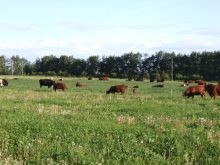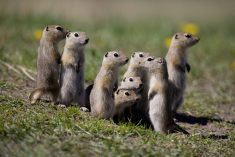When getting ready to send cattle out to grass this spring one big question to ask yourself is, do they need to be dewormed? In the past with our avermectins or pour-on products seeming to be effective in the fall and no chance of reintroduction over the winter we thought levels should be almost zero going into the spring. When testing cattle for internal parasites we are finding huge variation in the effectiveness of the pour-ons and hence the cattle’s parasite load. Cattle especially young calves or yearlings can be carrying quite a high load of parasites into the winter. That load should not change much over the winter so we must develop strategies as to what to do come spring if the cattle still have these parasitic loads.
Read Also

Body condition, nutrition and vaccination for brood cows
One of the remarkable events of the past century related to ranching has been the genetic evolution of brood cows….
If you want your cattle checked this spring take several golf ball-sized samples of fresh manure in a sealed zip-lock bag into your local clinic and have them run a fecal analysis using what is called a modified Wisconsin technique. This will give you an idea of the parasite load your cattle are taking to pasture whatever fall program you may use.
The avermectin products do a good job on lice in the fall and remove some of the internal worms. If you use them in combination with a benzimidazole product like Safeguard then the load carried over the winter should be essentially zero.
Research years ago showed deworming at turnout especially on young calves showed a weight gain benefit of about 30 pounds. The increase of course would be based on worm load as well as the milking ability of the cow, the quality of the pasture and whether the calves could be reinfected at pasture. We often forget that just because cattle are dewormed there is still a huge worm load out on many pastures waiting to be vacuumed up by grazing cattle.
If cattle go out essentially worm free from a good fall deworming then it is best to wait approximately three to four weeks so that a lot of the pasture parasites (certain larval stages of parasites survive Canadian winters) can be grazed and consumed. The worming then kills them before they start producing more eggs. The old adage is 99 per cent of the infective larvae are on the pastures and only one per cent of the worms are in the cattle.
The issue is they can be easily dewormed on pasture but it requires a prescription to put the product in the cattle mineral. If lungworms are an issue they can also be controlled but it may take another treatment later in the summer. Lungworms generally are more prevalent in late summer to early fall.
Most internal parasites have a life cycle of about three weeks in calves and about four to five weeks in cattle. If we avoid the routine avermectins in the spring we won’t take out the dung beetle which is responsible for breaking up the manure pack. They roll the manure up into smaller balls and bury them. With some of the metabolites of the avermectins being excreted through the bile and out the back plus cattle licking it off each other and taking it in orally there is a fair amount either of the original form or metabolized form coming out in the manure. This kills the dung beetle and one just has to recall how recently (in the last few years) manure patties have stayed pretty much intact through the entire summer to see the impact. In the past unless pastures were overgrazed manure patties were almost non-existent. I used to scoff at the notion of the dung beetle and yet we see the good they used to do by breaking down these patties so the nitrogen can help fertilize the grass for next year. If we can avoid the majority of the avermectins at turnout it will allow for recolonization of the dung beetles.
If we deworm once out on pasture gradually we can start to reduce the pasture contamination these cattle must face. The only easy way to continually monitor for parasites is through the manure and it is often best to check two weeks after deworming to see if the parasites have been brought under complete control.
All species of animals are susceptible to parasites to some degree. The good news is most parasites are species specific meaning they are unique to that group of animals. Bison on the other hand carry most of the cattle parasites but have a low tolerance for parasites. Sheep, goats and horses (all equines) need to deal with parasitism throughout their lives so they need to be monitored with fecal analysis and dewormed on average more often than cattle. Clinical parasitism such as weight loss, diarrhea, anemia or colic in horses are all possible signs of too many internal parasites as well. The same realities of pasture contamination apply to them as well.
If you have any questions on monitoring parasites or setting up deworming schedules talk to your veterinary clinic. They can devise control strategies that will be the most effective for your group of animals.















